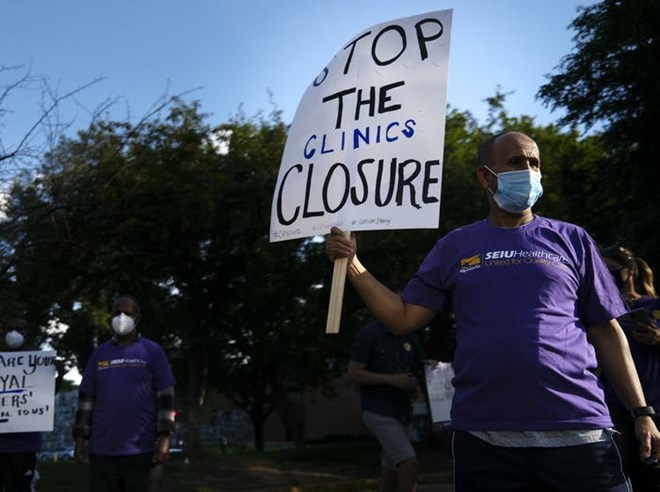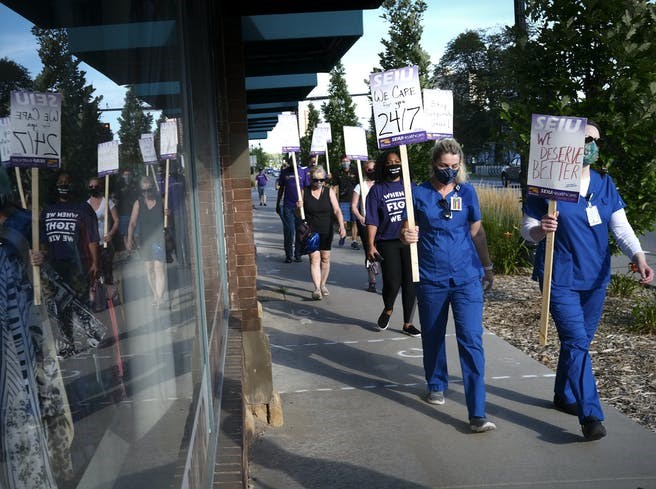
Monday August 3, 2020
By Christopher Snowbeck

Abdi Mohamed, of the Cedar Riverside neighborhood, came out to support health care workers and call for the reopening of the Riverside Clinic. AARON LAVINSKY, STAR TRIBUNE
Union workers and a DFL lawmaker are calling on HealthPartners to reopen its clinic in Cedar-Riverside, a Minneapolis neighborhood that’s been hard hit by the COVID-19 pandemic.
Riverside Clinic sits in one of Minnesota’s most diverse communities, so its closure makes it harder for people of color to get needed care, union workers have argued since the closing was announced in early July.
The permanent shutdown, which followed a temporary closing this spring because of COVID-19, was surprising given the coronavirus spread and also troubling considering the need for health care among immigrants from Somalia and Ethiopia who live nearby, said DFL Rep. Mohamud Noor, who represents the neighborhood.
“To walk away from this clinic is what I see as the structural racism that exists in our society,” Noor said during a protest outside the clinic late last week. “Closing this clinic is a shame to HealthPartners — they need to come back to reopen this clinic, to serve this community.”
HealthPartners does not plan to reopen Riverside, said Nance McClure, chief operating officer of the Bloomington-based care group. McClure disagreed with Noor’s claim that the closure is an example of structural racism, saying it was part of a broader move by the health system to close seven clinics in response to financial pressures and a shift of patients from brick-and-mortar clinics to online health care.
HealthPartners continues to serve diverse patients across the Twin Cities, McClure said, and is committed to closing gaps that leave people of color with worse health outcomes.
There are 25 primary care clinics within 2 ½ miles of Riverside, according to HealthPartners. The health system is now helping patients follow their health care providers to new locations or switch to care at nearby clinics.
“Our commitment to health equity is unwavering and, actually, I would say renewed, as we just look at the current events both with COVID and with the George Floyd killing,” McClure said.
On Sunday, Minnesota reported 769 new cases of COVID-19 and eight more deaths, bringing the pandemic’s toll in the state to 1,614. As in July, the August numbers are showing a relatively low number of new death reports daily and a relatively high number of new cases on a higher volume of tests.
The data from the Minnesota Department of Health also showed 302 patients hospitalized, with 149 in intensive care. The numbers are higher than what the state reported for most of July but lower than the peak for hospital demand in May.
Decline in demand
COVID-19 prompted hospitals and clinics across the country to delay many surgeries and elective procedures just as stay-at-home orders in many states kept many patients from visiting clinics. As a result, there’s been an unprecedented decline in patient demand for health care.
HealthPartners and other health systems responded by temporarily closing many clinics this spring, as more patients talked with doctors through “virtual visits” and online care options.

Community members and HealthPartners workers demonstrated against the Riverside Clinic’s closure in the Cedar-Riverside neighborhood, which is among 15 in Minneapolis with the highest number of COVID-19 cases. AARON LAVINSKY – STAR TRIBUNE
In April, more than one-third of primary care clinics surveyed said they were laying off or furloughing staff in response to the declines, said Ann Greiner, president and chief executive of the Primary Care Collaborative, a nonprofit group in Washington, D.C. Patients have been returning to clinics this summer, Greiner said, yet a survey supported by her group in late July found anecdotal evidence of clinic closures across the country.
“We’re very concerned about the loss of health care delivery infrastructure, particularly in lower-income communities, because they’re much more fragile,” said Dr. Georges Benjamin, executive director of the American Public Health Association. “There will be people who call up their doctor’s office and, tragically, find out their provider isn’t there.”
The Riverside closing eliminates 70 jobs, including some for members of SEIU Healthcare Minnesota, one of the unions that organized last week’s protest, which drew about 50 people.
Holly DeSouza, a nurse and union member, told the crowd gathered that she’s regularly getting calls from former Riverside patients with high blood pressure or high blood sugar readings. Their health care providers have moved to clinics in the suburbs, DeSouza said, and the patients don’t have the transportation to get there.
As a result, she said, some wind up getting care in the emergency department.
Minneapolis data show that Cedar-Riverside is one of 15 neighborhoods reporting more than 150 cases of COVID-19 — the highest level seen across more than 80 neighborhoods in the city.
Nearly two-thirds of residents living there are people of color, according to the Minnesota Department of Human Services (DHS). Immigrants from Somalia and Ethiopia who live in the area have relied on the Riverside Clinic for years, Noor said. He and his family, in fact, have been patients there.
Closing the clinic won’t help the state solve problems with health disparities, he added.
“The loss of access to clinical care in communities with large portions of people of color is especially concerning,” DHS said in a statement last month.
HealthPartners says it agrees with DHS and is working to help patients. The health system says it’s talking with People’s Center Clinic, located less than a quarter-mile from Riverside, to help patients switch to that location if it’s convenient.
For those who want to stay with HealthPartners, the health system has three clinics within 2.5 miles of Riverside, McClure said, and two others within 5 miles. HealthPartners is talking with individual doctors, nurse practitioners and physician assistants about where they want to relocate, McClure said, adding that some have opted to move about 4 miles to the Como Clinic in St. Paul.
About 14,000 patients per year received primary care services at Riverside, she said, and the number has been declining in recent years. Originally, the clinic was a large specialty center for HealthPartners patients at a time when the health system directed patients to nearby Fairview Riverside Hospital for inpatient care.
The clinic no longer has a close relationship with the nearby hospital, McClure said, and many specialty services have been moved to other centers around the region.
“The business context of why Riverside just is a location that doesn’t really fit with us, the way that it did back at its inception in the late 1980s, has nothing to do with health equity,” McClure said. “Our commitment to health equity remains every bit as strong.”